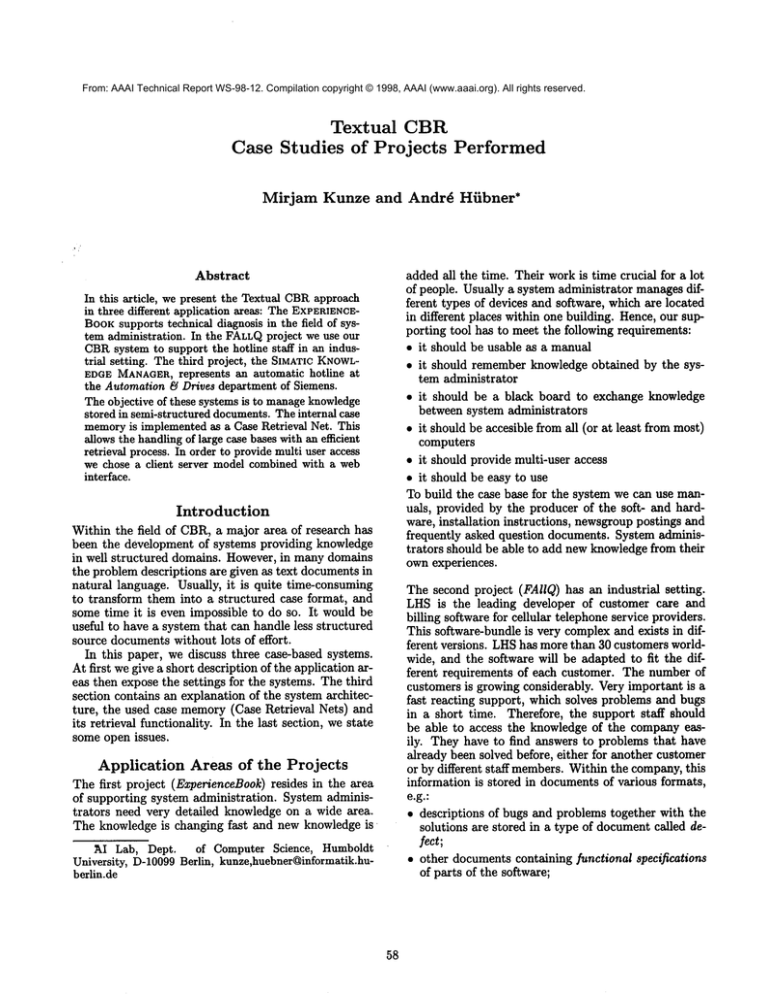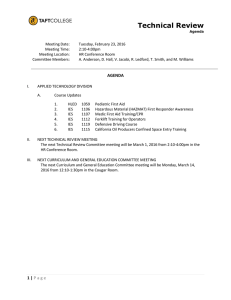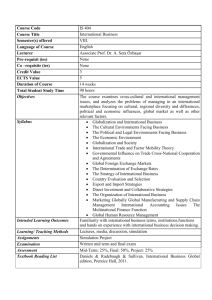
From: AAAI Technical Report WS-98-12. Compilation copyright © 1998, AAAI (www.aaai.org). All rights reserved.
Textual
CBR
Case Studies of Projects
Performed
Miriam Kunze and Andrd Hiibner*
added all the time. Their work is time crucial for a lot
of people. Usually a system administrator managesdifferent types of devices and software, which are located
in different places within one building. Hence, our supporting tool has to meet the following requirements:
¯ it should be usable as a manual
¯ it should remember knowledge obtained by the system administrator
¯ it should be a black board to exchange knowledge
between system administrators
¯ it should be accesible from all (or at least from most)
computers
¯ it should provide multi-user access
¯ it should be easy to use
To build the case base for the system we can use manuals, provided by the producer of the soft- and hardware, installation instructions, newsgrouppostings and
frequently asked question documents. System administrators should be able to add new knowledgefrom their
ownexperiences.
Abstract
In thisarticle,
we present
theTextual
CBRapproach
inthreedifferent
application
areas:
TheEXPERIENCEBOOKsupports
technical
diagnosis
inthefield
of systemadministration.
In theFALLQproject
we useour
CBRsystem
to support
thehotline
staffinan industrial setting. The third project, the SIMATIC
KNOWLEDGEMANAGER,represents an automatic hotline at
the Automation ~ Drives department of Siemens.
The objective of these systems is to manageknowledge
stored in semi-structured documents.The internal case
memoryis implementedas a Case Retrieval Net. This
allows the handlingof large case bases with an efficient
retrieval process. In order to provide multi user access
we chose a client server model combinedwith a web
interface.
Introduction
Within the field of CBR, a major area of research has
been the development of systems providing knowledge
in well structured domains. However, in many domains
the problem descriptions are given as text documents in
natural language. Usually, it is quite time-consuming
to transform them into a structured case format, and
some time it is even impossible to do so. It would be
useful to have a system that can handle less structured
source documentswithout lots of effort.
In this paper, we discuss three case-based systems.
At first we give a short description of the application areas then expose the settings for the systems. The third
section contains an explanation of the system architecture, the used case memory(Case Retrieval Nets) and
its retrieval functionality. In the last section, we state
some open issues.
The second project (FAIIQ) has an industrial setting.
LHSis the leading developer of customer care and
billing software for cellular telephone service providers.
This software-bundle is very complex and exists in different versions. LHShas more than 30 customers worldwide, and the software will be adapted to fit the different requirements of each customer. The number of
customers is growing considerably. Very important is a
fast reacting support, which solves problems and bugs
in a short time. Therefore, the support staff should
be able to access the knowledge of the company easily. They have to find answers to problems that have
already been solved before, either for another customer
or by different staff members.Within the company,this
information is stored in documents of various formats,
e.g.:
¯ descriptions of bugs and problems together with the
solutions are stored in a type of documentcalled defect;
¯ other documents containing functional specifications
of parts of the software;
Application Areas of the Projects
The first project (ExperienceBook) resides in the area
of supporting system administration. System administrators need very detailed knowledge on a wide area.
The knowledge is changing fast and new knowledge is
~kI Lab, Dept. of Computer Science, Humboldt
University, D-10099Berlin, kunze,huebner~informatik.huberlin.de
58
¯ Frequently Asked Question-like documents;
¯ manuals and documentations that are delivered with
the product.
LHSis a rapidly growing company, and new staff is
hired all the time. Newemployees lack the experience
of the senior ones. Their results depend on the knowledge obtained from documents. Currently, there are
more than 40,000 defect documents, and thousands are
added each year. So, a sytem is required which manages
large documentdatabases and efficiently finds relevant
information.
The Simatic Knowledge Manager (SKM)is used at the
customer support department at Siemens Automation
Drives.
In the business area of industrial automation systems
Siemens sells a variety of products, e.g. hardware components like CPUsand software systems. Most of these
products exist in different versions.
The customer support department already maintains
a web server, where the customers can find information
about the products. There are also around 2,000 FAQs
which describe solutions of problems for different products. All documents exist in different languages, e.g.
German, English, Italian, to support customers from
different countries. Due to the vast amount of documents, most customers give up on looking through the
documentsand call the hotline. A tool is required that
supports the customer to retrieve documents that are
important for his problem. This tool should be integrated into the hotline process. It should also be able
to support different languages.
Figure 1: Overview of the system
¯ Thesystemmustbe integrated
intoan existing
environment
(e.g.callcenters).
Design Overview
Textual CBR in Practice
Whenapplying
TextualCBRin practice,
thefollowing
issuesseemto be themostimportant:
¯ The systemmustbe easyto use.
¯ Theresultmustbe presented
fastafteraskingthe
query.
¯ The systemmustbe accessible
fromdifferent
kinds
of computers.
In the caseof SKM it mustevenbe
accessible
fromallovertheworld.
Wechose a client server architecture and implemented
a graphical user interface with HTML
pages that are
displayed by a WWW
browser to make the system accessible.
Figure 1 shows the major components of the implementation of the systems:
In an offiine process the source documents are
scanned and converted into a consistent case structure.
The resulting case documents are semi-structured documents containing a unique case number, several passages in natural language and some attributes.
The SKM,for instance, uses the following case format:
Case = ’’ [CASE_NUMBER]
’ ’ ’\n’
case_number ’ \n’.
’’[TITLE]’’ ’\n’
text_of_title’\n’.
"[RETRIEVAL.ATTRIBUTES]’ ’ ’\n’
[Av_Pair
{ ’\n’ Av_Pair
}] ’\n’.
¯ Ifthecasebasedoesn’t
contain
satisfying
entries
to
a query,theusershouldbe informed.
¯ Theretrieval
mechanism
shouldbe transparent
for
theuser.Forinstance,
heshould
be ableto recognize
whathappens
if he addsan attribute
to a query.
¯ Theusersof thesystemhaveto be considered
when
deciding
howmanypossibilities
an userwillhaveto
change
parameters
andoptions
of theretrieval.
¯ Oncethe systemis workingthe manualeffortfor
keeping
theknowledge
up-to-date
mustbe verylow.
¯ Mostof the maintenance
shouldbe doneautomatically
59
’’ [INFO_ATTRIBUTES]’’
’\n’
[AV_Pair { ’\n’ AV_Pair }] ’\n’.
’ ’ [DESCRIPTION]
’ ’ C\n’
text_of_symptoms’ \n ’
AV_Pair = attribute_name ’ ’ =’ ’
’ ’’ ’ attribute_value ’ ’’ ’.
Source documents are obtained from a filesystem or
a database and can occure in a variety of formats, e.g.
html, plain text. The preprocessor also uses simple information extraction methods to determine attribute
value pairs.
category of an IE: a subset of the set of IEs containing all textual IEs semantically belonging to the same
class of concepts.
index dictionary: contains the set of all index terms,
the rules of mapping the index vocabulary unique to
index terms and an unique mapping of each index
term to an IE category.
For representing a text with a set of textual IEs the
parsing algorithm
¯ reads the text word for word from left to right,
¯ looks for the first occuring word or sequence of words
matching with a string of the index vocabulary (if
shorter and a longer one start with the same word,
the longer one is preferred),
¯ maps this string to the according index term of the
index dictionary and
¯ adds the according textual IE to the set of IEs representing the case.
Beyondthis technique we use all attribute-value pairs
occuring in any attributes section directly as IEs.
Weapply a composite similarity measure: The more
IEs are shared by two cases the more similar are these
cases. A local similarity function is defined, which compares any two IEs. Doing so, two cases mayalso be similar if they are expressed in completly different words
which, however, can be mapped to similar IEs. The
values of the local similarity function is represented by
a similaity edge of the CttN.
The retrieval is done by a spreading activation mechanism: The incoming query activates IEs. They propagate their activation along the similarity and relevance
edges. The result is a preference ordering of cases based
on the achieved activations.
The retrieval server contains the internal case memory and the retrieval functionality.
The case server is able to receive case numbersand to
return the text of the according cases. This server can
be replaced by a simple database managementsystem.
The dictionaries contain general and domain specific
knowledge.
At the ExperienceBook there also exists a retain
server, which helps to expand the case base. A user
can send a newcase, which is put into a file. Later it is
manually prepared for a real update of the case base.
The clients (CGI-scripts) are needed to acces the
servers via the world wide web. They are also used
to build up the HTML-pages.
So the system is very easy to handle. The user only
has to fill HTML
forms and can navigate through the
result pages with a few clicks.
The Retrieval
Server
The heart of our implementation is the retrieval server.
With the help of several dictionaries, it builds an internal case memoryfrom the given case documents and
then provides the retrieval process for incoming client
requests.
For providing an efficient retrieval process we chose
as internal case memorythe model of Case Retrieval
Nets (CRNs) (Lenz & Burkhard 1996).
In this model, cases are represented as a part of a
graph. This graph is a net with the following nodes
and weighted edges:
¯ nodes for the identification ofcases (case descriptors);
¯ nodes for the information entities;
¯ edges to a case descriptor from all the IEs specifying this case (the weight of them is defined by the
relevance of one IE for a case);
¯ edges between IF, nodes expressing a similarity value
by a weight.
So, the semi-structured case documents have to be
represented by sets of information entities (IEs). The
structure of the cases allows to distinguish different text
sections and the attributes section. The relevant text
sections and the attributes section have to be mapped
to IEs.
For mappingplain text, a parsing algorithm uses one
of the dictionaries containing the set of all knownIEs:
index term: a concept representing a set of strings
describing the same semantic content like grammatical forms, abbreviations or different kinds of spelling
(e.g. "PostScript-Drucker" : "PS-Drucker", "Postscript printer").
index vocabulary: the set of all strings knownwithin
a case based system that can be mapped to index
terms.
Every index term has an IE as representant.
The
set of index terms (resp. textual IEs) is divided into
different categories, e.g. the category "domainspecific
term", "computer term" or "general term" .
Open Issues
Evaluation is not yet addressed sufficiently. However,
measures like precision and recall are not directly applicable for our purposes (Lenz 1998). For example
satisfying result is already achieved if only one matching case is presented to the user.
A major topic of our future work is improving the
data maintenance. The expansion of the set of IEs
should become more easy. In both projects, most of
the IEs have been gained manually by extracting them
from the cases or from general sources like dictionaries
or glossaries. In future, a suggestion should be generated automatically.
To improve the performance of the system we are
currently testing further Information Extraction methods. With these methods we can extract attributes and
IEs more effectivly. Also the maintenance of the local
similarities should be more user-friendly. Perhaps some
kind of similarity assistant might be useful.
Another topic is developing the similarity measure.
We think about including shallow Natural Language
Processing or using more Information Retrieval methods.
6O
References
Gierl, L., and Lenz, M., eds. 1998. 6th GermanWorkshop on CBR, Rostock: University of Rostock.
GSrz, G., and Hflldobler, S., eds. 1996. KI-96: Advances in Artificial Intelligence, Lecture Notes in Artificial Intelligence, 1137. Springer Verlag.
Kunze,
M.
The ExperienceBook. http://informatik.hu-berlin.de/
,,~kunze/studienaxbeit.ps.
Leake, D. B., and Plaza, E., eds. 1997. CaseBased Reasoning Research and Development, Proc.
ICCBR-97,Lecture Notes in Artificial Intelligence,
1266. Springer Verlag.
Lenz, M., and Burkhard, H.-D. 1996. Case Retrieval Nets: Basic ideas and extensions. In Gfrz and
HSlldobler (1996), 227-239.
Lenz, M. 1998. Textual CBRand Information Retrieval -- A Comparison--. In Gierl and Lenz (1998),
59-66.
61





